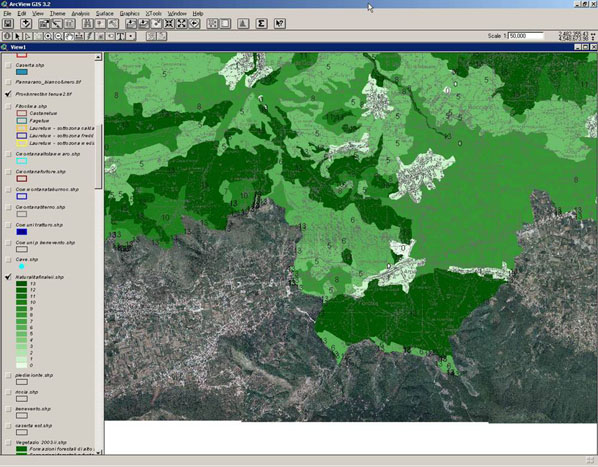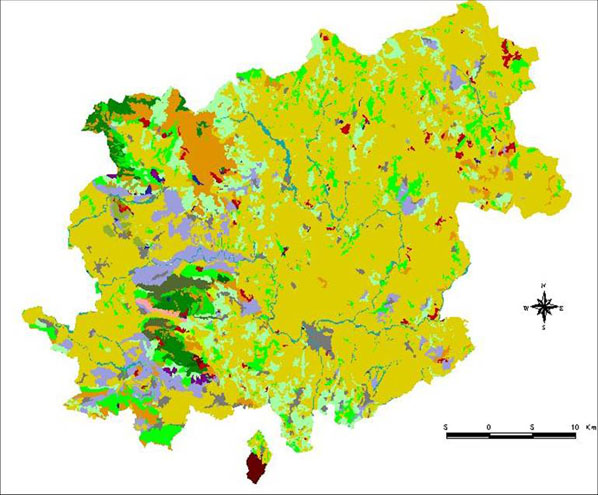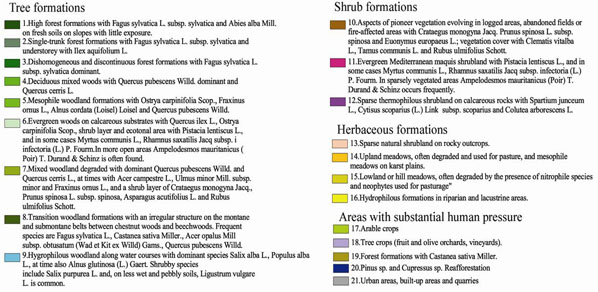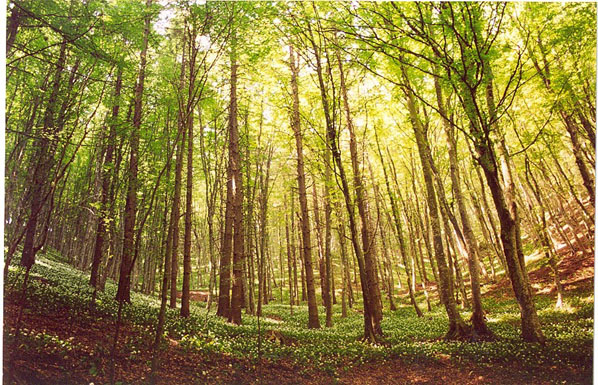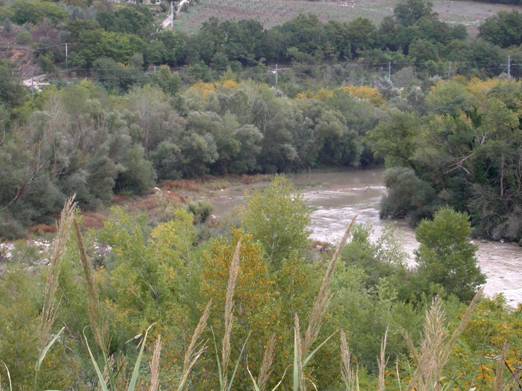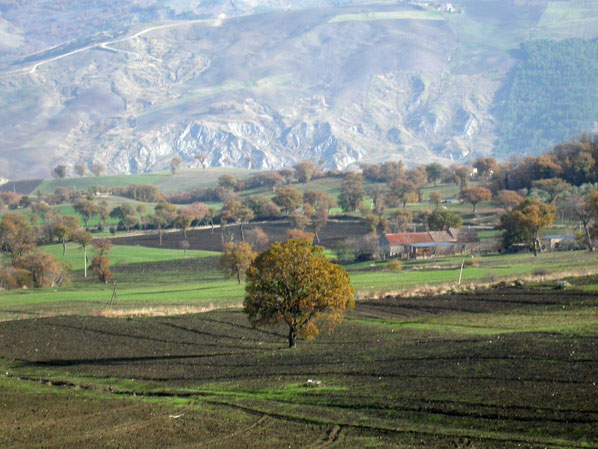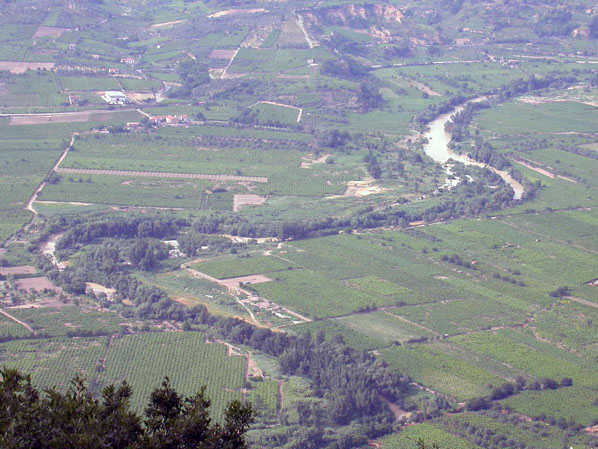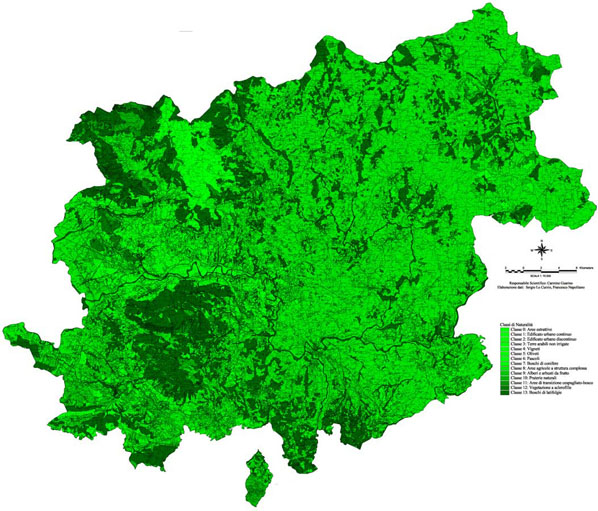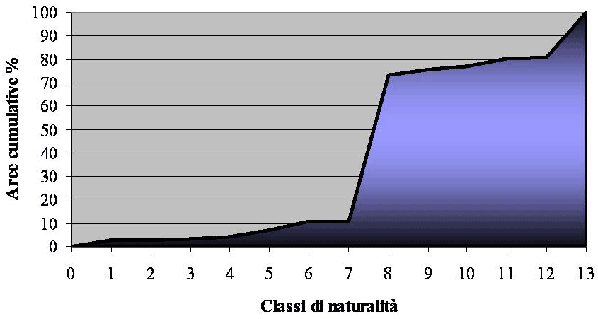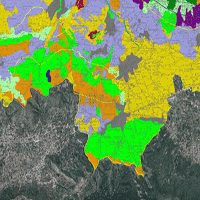
Assessment of vegetation and naturalness: a study case in Southern Italy
iForest - Biogeosciences and Forestry, Volume 1, Issue 3, Pages 114-121 (2008)
doi: https://doi.org/10.3832/ifor0452-0010114
Published: Jul 09, 2008 - Copyright © 2008 SISEF
Technical Reports
Abstract
The study of vegetation and naturalness in the province of Benevento (southern Italy) was conducted through a series of complementary steps starting from a preliminary phase of bibliographical research. To draw up the theme map, after the preparatory phase of GIS-based cartographic support, a photo-interpretation phase was conducted for the whole province of Benevento on the basis of orthophotos at a scale of 1:10.000 taken in 1997-1998 supplied by the Provincial Authority. We produced a map which chiefly takes account of the physiognomic features of vegetation alongside floristic data. Throughout the province of Benevento we identified 21 main floristic types grouped into four categories, which include three physiognomic categories and one category grouping the areas greatly affected by human impact. For each vegetation type we calculated the percentage of the area against the whole surface area of the province. Starting from the vegetation map, the vegetation types in the area were reclassified according to the scale of naturalness ordered according to the criterion of proximity to the mature vegetation phase. The conservation status of the plant landscape in the province of Benevento was thus assessed by using the ILC (Index of Landscape Conservation).
Keywords
GIS, Vegetation map, Naturalness map, ILC (Index of Landscape Conservation)
Introduction
In the context of biodiversity conservation and sustainable land management, the environmental mosaic has to be analysed, described and indexed. Assessment of the degree of plant landscape conservation is a most interesting objective for careful, modern land management. Vegetation comprises:
- the environmental component for identifying the biotopes as defined by the EC Habitat Directive;
- the primary kingdom of biodiversity;
- what actually determines the structure of animal communities;
- one of the most significant indicators of the degree of environmental quality and for correlating the biosphere with the substrate;
- biomass involved in soil formation, dynamics and evolution;
- the biological element of climatic mitigation;
- the component to which the key role of ecological protection is attributed;
- the most versatile renewable natural resource.
Consequently, it appears evident that, from the analysis of vegetation quality and its distributional range, it is possible to identify the degree of landscape conservation (naturalness) which may be assessed on the basis of consistency, or otherwise, with the soil vegetation cover and the corresponding potential vegetation ([3], [20]).
A vegetation map usually involves the representation of similar plant categories and communities grouped by certain features and defined on the basis of vascular plants. Although some plant forms such as bryophytes and fungi are excluded, this does not mean that the vegetation map is a mere construct: it represents the distribution of vegetation types consisting of autotrophic plants which constitute the source of an area’s primary productivity. All the other organic components of the environment, from fungi to animals, depend trophically on vegetation and on its variations in space and time. The plant cover of an area, when there is no external human pressure, tends towards a state of equilibrium with the environment in which it develops and tends to be distributed uniformly in homogeneous area contexts, resulting in a continuous phenomenon.
Here we present a multi-phase study of the vegetation and consequent naturalness of the province of Benevento, starting from a preliminary bibliographical research phase ([15], [7], [8], [9], [10], [12], [13], [14], [17], [16], [2]).
Material and methods
To draw up the thematic map, the preparatory phase of GIS-based cartographic support was followed by photointerpretation performed on the whole area of the province of Benevento on the basis of 1997-1998 orthophotos at a scale of 1: 10.000 supplied by the Provincial Authority. Each vegetation type was selected according to a subdivision of the various physiognomies which was possible by making allowances for colour hue and saturation; the areas were then classified according to the legend of the Campania soil use map at a scale of 1:50.000, in turn appropriately integrated thanks to field surveys which allowed the item “broad-leafed woods” to be broken down into nine forest types. This enabled us to enrich the ecological information expressed by each of them.
Field surveys were subsequently carried out to confirm the physiognomic data and to collect floristic data according to scheduled campaigns, using the model of area subdivision into IGM sheets at 1:50.000, each subdivided into sixteenths, as originally adopted for the floristic map of central Europe ([18]). Each survey unit created represents an area of 4.000 hectares. By conducting floristic surveys we analysed the mapped categories, the definition of vegetation attributions and grouping of the items in the legend, with particular regard to natural and seminatural vegetation.
Each plant community, in terms of its floristic features, was assessed in sample areas of known sizes (250 m2). In particular, in areas covering great altitudinal differences, more than one sample area was analysed. The subsequent phase was that of delimiting areas on a cartographic basis, their digitization and their subsequent processing within the Geographic Information system. The maps were then reproduced on paper according to 1:50.000 sheets (Tab. 1). Here we create a map which chiefly takes into account the physical features of the vegetation alongside floristic data (Fig. 1).
Tab. 1 - List of IGM maps covering the province of Benevento.
| IGM Sheet Scale | No. | Main Locality |
|---|---|---|
| 1:50 000 | 432 | Benevento |
| 1:50 000 | 406 | Riccia |
| 1:50 000 | 418 | Piedimonte |
| 1:50 000 | 431 | Caserta Est |
| 1:50 000 | 419 | S. Giorgio la Molara |
| 1:50 000 | 407 | S. Bartolomeo in Galdo |
| 1:50 000 | 420 | Troia |
The state of conservation of the vegetation landscape in the area of the Province of Benevento was assessed by using the ILC (Index of Landscape Conservation - [19]). Starting from the vegetation map, the vegetation types in the area were then reclassified by the scale of naturalness according to the criterion of proximity to the mature vegetation phase ([1], [4], [5] - Fig. 2). Below we report the table of the various areas considered and the relative scale of values attributed to each (Tab. 2).
Tab. 2 - Naturalness classes. The sequence is ordered according to the criterion of nearness to the mature vegetation phase ([4]).
| Classes | Vegetation phase |
|---|---|
| 0 | Extraction areas |
| 1 | Continuous urban built up |
| 2 | Discontinuous urban built up |
| 3 | Arable crops not watered |
| 4 | Vineyard |
| 5 | Olive orchards |
| 6 | Pastures |
| 7 | Coniferous woodland |
| 8 | Agricultural areas to complex structure |
| 9 | Fruity trees and shrubs (chestnut copse) |
| 10 | Natural prairie |
| 11 | Transition areas bushy/woody |
| 12 | Sclerophyll vegetation (Ampelodesmos and Mediterranean maqui) |
| 13 | Broadleaf woodland |
Starting from the vectorial map of natural vegetation of the province of Benevento ([11]), all the categories of the naturalness classes were identified, and for each category the overall percentage area was calculated for the whole province. This was carried out by using the XTOOLS extension of ArcView 3.3 ([6]). For this purpose a graph was constructed with the area’s naturalness classes reported on the x axis in ascending order and the sum of cumulative percentages of the corresponding areas on the y axis; the area below the curve may be expressed as (eqn. 1):
where n is the number of naturalness classes (n = 14) and xi is the cumulative percentage of the i-th category. A expresses the degree of human impact in the area. The higher the degree, the greater is the contribution to the total on the part of categories with higher human impact. The highest value which A can reach is expressed as follows (eqn. 2):
The ILC, which supplies summarised information on the degree of landscape conservation, is thus formulated as follows (eqn. 3):
The value of ILC, which varies from 0 (minimum) to 1 (maximum), is proportional to the area of the Cartesian plane above the curve of cumulative percentages. Index values close to one define a landscape with high naturalness while values close to zero indicate a landscape with considerable human impact and hence with low naturalness.
Results and discussion
Vegetation
Throughout the province of Benevento we identified 21 main floristic and physiognomic types (Fig. 3 and Fig. 4) grouped into four categories, comprising three physiognomic categories and one that grouped areas showing considerable human impact. For each vegetation type we calculated the percentage surface area compared with the whole provincial area (Tab. 3).
Tab. 3 - Surface areas of the 21 vegetation classes in the province.
| Vegetation classes | Surface areas (mq) | n. Polygon | Surface % |
|---|---|---|---|
| 1 | 1 493 715 | 2 | 0.07 |
| 2 | 39 623 673 | 18 | 1.9 |
| 3 | 11 728 763 | 25 | 0.57 |
| 4 | 183 844 789 | 591 | 8.86 |
| 5 | 9 898 846 | 2 | 0.47 |
| 6 | 8 203 878 | 14 | 0.39 |
| 7 | 53 624 827 | 387 | 2.58 |
| 8 | 3 182 970 | 2 | 0.15 |
| 9 | 30 639 405 | 61 | 1.47 |
| 10 | 23 001 095 | 109 | 1.1 |
| 11 | 743 581 | 10 | 0.035 |
| 12 | 3 436 074 | 2 | 0.16 |
| 13 | 4 277 115 | 7 | 0.2 |
| 14 | 111 733 609 | 142 | 5.38 |
| 15 | 744 809 | 3 | 0.035 |
| 16 | 260 785 | 2 | 0.012 |
| 17 | 1 140 055 067 | 2410 | 54.9 |
| 18 | 376 061 517 | 9198 | 18.15 |
| 19 | 15 987 494 | 7 | 0.76 |
| 20 | 4 665 639 | 39 | 0.22 |
| 21 | 53 624 827 | 198 | 2.59 |
Tree formations
This group contains wood and forest vegetation types. The category was subdivided into nine floristic types identified by the dominant and co-dominant species representing the plant community which were identified, delimited and mapped.
1. “High forest formations with Fagus sylvatica L. subsp. sylvatica and Abies alba Mill. on fresh soils on slopes with little exposure”. This term is used to describe forests of beech (Fagus sylvatica L.) and silver fir (Abies alba Mill.) in which there is no clear dominance of beech over fir or vice versa. These forests are - used to be - managed for timber production, and are consequently mono-layered, in that the shrub layer is absent and the herbaceous layer is scarcely developed. Hedera helix L. s.l. appears sporadically. Distribution of these forests is restricted to the carbonatic complex of Taburno-Camposauro.
2. “Single-trunk forest formations with Fagus sylvatica L. subsp. sylvatica and understorey with Ilex aquifolium L.”. This term is used to identify beech forests (Fagus sylvatica L.) which are managed to produce single trunks; precisely due to their particular management they have structural features which give them a rather simple single-layered organisation in which the shrub understorey is discontinuous, and herbaceous plants are little represented; some bulbous and/or rhizomatous plants are found in the winter-spring period. Of the various species, the one which is particularly common is Allium ursinum L. (Fig. 5) which forms continuous, uniform carpets especially in the forest areas in the higher montane sectors. This vegetation type occurs on the upper slopes of the Taburno-Camposauro carbonatic complex, the eastern part of Mt Matese starting from roughly 1000 m a.s.l.
3. “Dishomogeneous and discontinuous forest formations with Fagus sylvatica L. subsp. sylvatica dominant”. This definition is used for sectors in which, due to soil and high altitude, the beech forest gives way to grassland on the limestone ridges and on steep slopes. In these sectors, beech trees have a different growth habit and the spatial arrangement of individual trees is far removed from that of single-trunk trees. Many herbaceous bulb species appear in the understorey and in marginal areas.
4. “Deciduous mixed woods with Quercus pubescens Willd. dominant and Quercus cerris L.”. This definition is used to describe coppiced woods consisting chiefly of downy oak (Quercus pubescens Willd.) and turkey oak (Quercus cerris L.). These woods are found throughout the province and represent 54% of the whole forested area. Many are coppiced woods which chiefly grow in the eastern sector of the province in flysch hill areas dominated by farmland.
5. “Mesophile woodland formations with Ostrya carpinifolia Scop., Fraxinus ornus L., Alnus cordata (Loisel) Loisel and Quercus pubescens Willd.”. This term is used to identify woods that grow in cool edaphic conditions with moderately deep soils on slopes with little exposure. These woods are exploited for firewood and have a very rich and heterogeneous floristic composition varying from sector to sector, although the dominant woody species are chiefly those cited in the legend. These woods also have a very complex structure due to the great heterogeneity of age classes of each constituent plant population. Plant cover is usually very dense and rich in lianous plant species. The best example of such woods is on the northern slope of Mt Camposauro.
6. “Evergreen woods on calcareous substrates with Quercus ilex L., Ostrya carpinifolia Scop., shrub layer and ecotonal area with Pistacia lentiscus L., and in some cases Myrtus communis L., Rhamnus saxatilis Jacq subsp. infectoria (L.) P. Fourm. In more open areas Ampelodesmos mauritanicus (Poir) T. Durand & Schinz is often found.” The description is used to identify evergreen sclerophyll woods of the Mediterranean maquis as reported in the legend. These woods are usually coppiced, as can be seen on Mt Acero, Mt Pugliano, Mt Camposauro and on the south side of Mt Taburno. Indeed, Taburno is the best example of this type of vegetation, representing at the same time a site of major geobotanical interest with a high degree of biodiversity. Although such woods appear rather uniform, their floristic composition undergoes fairly significant variations according to slope exposure, such as the presence of holm oak (Quercus ilex L.).
7. “Mixed woodland degraded with dominant Quercus pubescens Willd. and Quercus cerris L., at times with Acer campestre L., Ulmus minor Mill. subsp. minor and Fraxinus ornus L., and a shrub layer of Crataegus monogyna Jacq., Prunus spinosa L. subsp. spinosa, Asparagus acutifolius L. and Rubus ulmifolius Schott”. This category includes all those woodlands with a high degree of fragmentation and of fairly small size, being residual parts of woods that have disappeared. Although they appear to be highly variable and sub-optimally conserved, they represent plant communities with a high degree of biodiversity and vegetation dynamism.
8. “Transition woodland formations with an irregular structure on the montane and submontane belts between chestnut woods and beechwoods. Frequent species are Fagus sylvatica L., Castanea sativa Miller., Acer opalus Mill subsp. obtusatum (Wad et Kit ex Willd) Gams., Quercus pubescens Willd.”. This formation covers all those woods between well-defined, stable and homogeneous woodland. They represent a condition of instability dictated by human pressure. This is why they may include species not usually found in stable woods.
9. “Hygrophilous woodland along water courses with dominant species Salix alba L., Populus alba L., at time also Alnus glutinosa (L.) Gaert. Shrubby species include Salix purpurea L. and, on less wet and pebbly soils, Ligustrum vulgare L. is common” (Fig. 6). This definition covers the set of riparian vegetation found especially along the main water courses and along a few streams that are large enough to be mapped using the scale adopted. Included in this category are herbaceous plant species such as reeds which are at times mixed with arboreal vegetation, especially where water flows slowly.
Fig. 6 - Riparian wood with white willow (Salix alba) and European aspen (Populus tremula) on a stretch of the rivers Volturno and Calore Beneventano. In the foreground the flowering culms of the dwarf reed (Arundo plinii Turra).
Shrub formations
This group consists of fruticose and suffruticose woody perennials under six metres tall. It is divided into four floristic and physiognomic types, identified by their dominant and co-dominant species.
10. “Aspects of pioneer vegetation evolving in logged areas, abandoned fields or fire-affected areas with Crataegus monogyna Jacq. Prunus spinosa L. subsp. spinosa Euonymus europaeus L.; vegetation cover with Clematis vitalba L., Tamus communis L. and Rubus ulmifolius Schott”. This definition is used for areas with vegetation chiefly consisting of shrubby species, although their presence does not wholly exclude tree species. Such shrublands are almost always isolated or occur close to coppiced woods. This is the vegetation that recolonises former coppiced woodland, no longer managed or maintained, abandoned cropland or areas hit by wild-fires. It has a punctiform distribution in various parts of the province.
11. “Evergreen Mediterranean maquis shrubland with Pistacia lentiscus L., and in some cases Myrtus communis L., Rhamnus saxatilis Jacq subsp. infectoria (L.) P. Fourm. In sparsely vegetated areas Ampelodesmos mauritanicus (Poir) T. Durand et Schinz occurs frequently.” This definition is used for evergreen shrub cover which develops on the edges of thermophilous coppiced woods. Although the composition of these shrubberies is limited in terms of shrubby species, they contain herbaceous species which manage to survive only in these types of plant communities. Moreover, in areas where edaphic conditions are particularly inhospitable due to the presence of frequent outcroppings, Mauritanian grass (Ampelodesmos mauritanicus) becomes dense. This vegetation formation occurs somewhat locally on the belt at the base of Mt Acero, Mt Pugliano and on the hills of the Common of Ginestra degli Schiavoni.
12. “Sparse thermophilous shrubland on calcareous rocks with Spartium junceum L., Cytisus scoparius (L.) Link subsp. scoparius and Colutea arborescens L.” This formation usually grows on detritic limestone areas on well-exposed slopes. Single species communities can form such as the singular case on Mt. Camposauro at the northern edge of the Prata Plain at about 1000 m a.s.l.
13. “Sparse natural shrubland on rocky outcrops”. This is used to define particularly sparse plant cover which grows on calcareous rocks at hill and submontane levels. The species are represented by small suffruticose shrubs, bulbous and rhizomatous plants.
Herbaceous formations
This group includes both stable and successional spontaneous herbaceous vegetation consisting of annual, biennial and perennial herbaceous species. This category was subdivided into three floristic types identified by their dominant and co-dominant species.
14. “Upland meadows, often degraded and used for pasture, and mesophile meadows on karst plains”. This expression is used to identify all the areas affected by stable herbaceous vegetation always used for pasture. These are particularly rich in species belonging to the family of Graminaceae; also numerous are broad-leaf species which indicate extensive exploitation of the pastures. This vegetation formation is found on the limestone reliefs of Mt. Taburno, Mt. Camposauro, Mt. Matese and on carstic plains such as Piano Melaino and Piano Campo.
15. “Lowland or hill meadows, often degraded by the presence of nitrophile species and neophytes used for pasturage”. This is used to identify unstable successional grassland found chiefly in hill areas. Such grassland is also heavily exploited for pasturage, but it has a greater floristic diversity than upland meadows and enjoys a better state of conservation probably because it grows on more fertile soil under less selective climatic conditions. It is best exemplified by the stretch of Regio Tratturo in the Common of Morcone.
16. “Hydrophilous formations in riparian and lacustrine areas”. This expression is used to identify all the riparian and lacustrine areas affected chiefly by annual, biennial or at times perennial herbaceous vegetation which are hard to map on the scale adopted. Prime areas are the lakes of Telese and Decorata.
Areas with substantial human pressure
This group includes all the areas heavily affected by human pressure which show a marked simplification in vegetation structures, a numerically floristic composition and a marked presence of human interventions. This category was subdivided into the following five types.
17. “Arable crops”. This is used to identify all the areas where seasonal crops are planted. It is particularly widespread through the province and constitutes the dominant element of the landscape, forming its matrix (Fig. 7).
18. “Tree crops (fruit and olive orchards, vineyards) ”. This term is used to identify all the areas cultivated with intensive monospecific tree crops in irrigated areas. This vegetation type is chiefly represented by olive orchards, mixed fruit orchards chiefly at the foothills of the southern slope of Mt Taburno and the extremity of the Matese chain on Mt Erbano; this vegetation type is also found in the easternmost part of the province in the area of the mountain community of Fortore. Vineyards are chiefly found in the mid-valley of the River Calore and in the Telese valley in the Commons of Solopaca, S. Salvatore Telesino, Amorosi and Telese (Fig. 8).
Fig. 8 - Typical fluvial corridor crossing an agroecosystem in the Telese valley. Rivers Volturno and Calore Beneventano SCI.
19. “Forest formations with Castanea sativa Miller”. This class includes all the woods consisting primarily of sweet chestnut (Castanea sativa Miller). The fruit-bearing chestnuts have an irregular planting system. The distances between individual trees are fairly large, though they are far from being naturally arranged. The trees are also appropriately pruned, which is why they often assume a squat shape. They are found on Mt. Taburno and Mt. Camposauro. Coppiced chestnut woods occur on hills in the southwestern portion of the province on the border with the provinces of Avellino and Caserta.
20. “Pinus sp. and Cupressus sp. reafforestation”. This description is used to identify all the areas in which conifers were planted as reported in the legend. The appearance and structural organisation of these plantations are variable, but they are generally somewhat simplified and lacking in natural aspects.
21. “Urban areas, built-up areas and quarries”. This class is used to identify areas affected by continuous and discontinuous urbanisation, industrial areas such as large industrial hangars and forecourts, and areas affected by extractive industries both on river beds and elsewhere.
Naturalness
Naturalness Map (1:50.000) for the province of Benevento is shown in Fig. 9.
The diagram of the cumulative percentages in relation to the whole area of Benevento province (Fig. 10) shows that the plant landscape maintains a fair degree of conservation. Occupying a total of 2000 km2, this area is particularly suitable to agriculture and forestry. In the whole province, we identified all the 14 classes of naturalness. For each class, the percentage of the area was assessed, as reported by Tab. 4. From the cumulative percentage values we calculated the overall ILC value for the whole province (0.59), which corresponds to an above-average degree of naturalness.
Fig. 10 - Diagram of the cumulative percentages for the whole province. The area above the curve is the degree of naturalness.
Tab. 4 - Naturalness classes, surface areas and percentages at a provincial scale.
| Vegetation classes |
No. Polygon |
Surface (ha) |
% of each class |
Percentual sum |
|---|---|---|---|---|
| 0 | 88 | 37 574 | 0.19 | 0.19 |
| 1 | 105 | 519 031 | 2.69 | 2.88 |
| 2 | 7 | 23 093 | 0.12 | 3 |
| 3 | 16 | 57 146 | 0.29 | 3.29 |
| 4 | 14 | 176 631 | 0.91 | 4.2 |
| 5 | 93 | 523 538 | 2.71 | 6.91 |
| 6 | 55 | 732 491 | 3.8 | 10.71 |
| 7 | 40 | 51 550 | 0.26 | 10.97 |
| 8 | 436 | 11 988 154 | 62.14 | 73.11 |
| 9 | 65 | 437 695 | 2.26 | 75.37 |
| 10 | 90 | 316 006 | 1.64 | 77.01 |
| 11 | 175 | 630 483 | 3.3 | 80.31 |
| 12 | 13 | 73 876 | 0.39 | 80.7 |
| 13 | 1840 | 3 722 662 | 19.3 | 100 |
What emerges from the table of surface areas of naturalness classes, the most representative element is undoubtedly naturalness class 8 which defines complex farmland in which arable crops are most common. This class is immediately followed by naturalness class 13 which represents the maximum expression of naturalness (broadleaf woodland). This vegetation type occupies 19.3%, that is, one-fifth of the whole province. The other categories occupying fairly extensive, albeit smaller, areas which have a significant weight and contribute to increasing the degree of naturalness are classes 9, 10 and 11 with their respective percentages of 2.26%, 1.64% and 3.3%. Of similar interest are naturalness classes 5 (2.71%) and 6 (3.8%) representing olive orchards and pastures, respectively. What reduces the degree of landscape conservation are built-up areas with their continuous and discontinuous urban structure and the mining areas, which together amount to 3% of the whole province. All the other naturalness classes amount to less than 1%, which is why they do not particularly affect the conservation plant landscape naturalness in the province.
Conclusion
The Benevento area shows, in terms of biodiversity, a great natural potential which should be protected and enhanced. The particular geolithological origins and geomorphological conformation, as well as the area’s water resources, make its plant communities of great environmental value. Rare endemic species of phytogeographic interest, together with natural phenomena such karst formations, dolines and many springs, contribute to making this area an environment with high natural value.
References
Gscholar
Gscholar
Gscholar
Gscholar
Gscholar
Gscholar
Gscholar
Gscholar
Gscholar
Gscholar
Gscholar
Gscholar
Gscholar
Gscholar
Gscholar
Gscholar
Gscholar
Gscholar
Gscholar
Authors’ Info
Authors’ Affiliation
S Santoro
L De Simone
Dipartimento di Scienze Biologiche e Ambientali, Università degli Studi del Sannio, v. Port’Arsa 11, I-82100 Benevento (Italy)
Corresponding author
Paper Info
Citation
Guarino C, Santoro S, De Simone L (2008). Assessment of vegetation and naturalness: a study case in Southern Italy. iForest 1: 114-121. - doi: 10.3832/ifor0452-0010114
Paper history
Received: Nov 26, 2007
Accepted: Jan 31, 2008
First online: Jul 09, 2008
Publication Date: Jul 09, 2008
Publication Time: 5.33 months
Copyright Information
© SISEF - The Italian Society of Silviculture and Forest Ecology 2008
Open Access
This article is distributed under the terms of the Creative Commons Attribution-Non Commercial 4.0 International (https://creativecommons.org/licenses/by-nc/4.0/), which permits unrestricted use, distribution, and reproduction in any medium, provided you give appropriate credit to the original author(s) and the source, provide a link to the Creative Commons license, and indicate if changes were made.
Web Metrics
Breakdown by View Type
Article Usage
Total Article Views: 48513
(from publication date up to now)
Breakdown by View Type
HTML Page Views: 40874
Abstract Page Views: 3007
PDF Downloads: 3667
Citation/Reference Downloads: 92
XML Downloads: 873
Web Metrics
Days since publication: 6389
Overall contacts: 48513
Avg. contacts per week: 53.15
Article Citations
Article citations are based on data periodically collected from the Clarivate Web of Science web site
(last update: Mar 2025)
Total number of cites (since 2008): 3
Average cites per year: 0.17
Publication Metrics
by Dimensions ©
Articles citing this article
List of the papers citing this article based on CrossRef Cited-by.
Related Contents
iForest Similar Articles
Research Articles
Evaluation of urban forest landscape health: a case study of the Nanguo Peach Garden, China
vol. 13, pp. 175-184 (online: 02 May 2020)
Research Articles
Remote sensing of Japanese beech forest decline using an improved Temperature Vegetation Dryness Index (iTVDI)
vol. 4, pp. 195-199 (online: 03 November 2011)
Research Articles
Fragmentation of Araucaria araucana forests in Chile: quantification and correlation with structural variables
vol. 9, pp. 244-252 (online: 28 August 2015)
Research Articles
Endangered and endemic species increase forest conservation values of species diversity based on the Shannon-Wiener index
vol. 9, pp. 469-474 (online: 02 January 2016)
Research Articles
Ecological factors affecting the recent Picea abies decline in Slovenia: the importance of bedrock type and forest naturalness
vol. 16, pp. 105-115 (online: 29 March 2023)
Review Papers
The forest biodiversity artery: towards forest management for saproxylic conservation
vol. 9, pp. 205-216 (online: 26 October 2015)
Research Articles
Assessing the habitat conservation status by soil parameters and plant ecoindicators
vol. 7, pp. 170-177 (online: 14 February 2014)
Research Articles
Mapping Leaf Area Index in subtropical upland ecosystems using RapidEye imagery and the randomForest algorithm
vol. 7, pp. 1-11 (online: 07 October 2013)
Research Articles
Scale dependency of the effects of landscape structure and stand age on species richness and aboveground biomass of tropical dry forests
vol. 16, pp. 234-242 (online: 23 August 2023)
Technical Reports
Conservation and use of elm genetic resources in France: results and perspectives
vol. 13, pp. 41-47 (online: 03 February 2020)
iForest Database Search
Search By Author
Search By Keyword
Google Scholar Search
Citing Articles
Search By Author
Search By Keywords
PubMed Search
Search By Author
Search By Keyword


